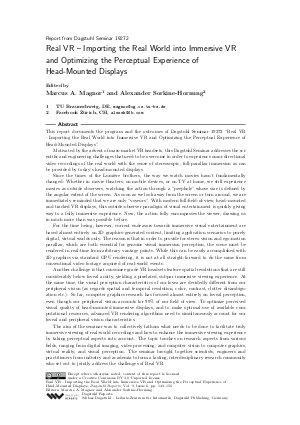Real VR - Importing the Real World into Immersive VR and Optimizing the Perceptual Experience of Head-Mounted Displays (Dagstuhl Seminar 19272)
Authors Marcus A. Magnor, Alexander Sorkine-Hornung and all authors of the abstracts in this report
-
Part of:
Issue:
Dagstuhl Reports, Volume 9, Issue 6
Part of: Volume: Dagstuhl Reports, Volume 9
Part of: Journal: Dagstuhl Reports (DagRep) - License:
 Creative Commons Attribution 3.0 Unported license
Creative Commons Attribution 3.0 Unported license
- Publication Date: 2019-11-28
File

PDF
DagRep.9.6.143.pdf
- Filesize: 5.66 MB
- 14 pages
Document Identifiers
Subject Classification
Keywords
- immersive digital reality
- perception in vr
- real-world virtual reality
Metrics
- Access Statistics
-
Total Accesses (updated on a weekly basis)
0PDF Downloads0Metadata Views
Abstract
This report documents the program and the outcomes of Dagstuhl Seminar 19272 "Real VR -- Importing the Real World into Immersive VR and Optimizing the Perceptual Experience of Head-Mounted Displays". Motivated by the advent of mass-market VR headsets, this Dagstuhl Seminar addresses the scientific and engineering challenges that need to be overcome in order to experience omni-directional video recordings of the real world with the sense of stereoscopic, full-parallax immersion as can be provided by todays head-mounted displays. Since the times of the Lumière brothers, the way we watch movies hasn’t fundamentally changed: Whether in movie theaters, on mobile devices, or on TV at home, we still experience movies as outside observers, watching the action through a "peephole" whose size is defined by the angular extent of the screen. As soon as we look away from the screen or turn around, we are immediately reminded that we are only "voyeurs" With modern full-field-of-view, head-mounted and tracked VR displays, this outside-observer paradigm of visual entertainment is quickly giving way to a fully immersive experience. Now, the action fully encompasses the viewer, drawing us in much more than was possible before. For the time being, however, current endeavors towards immersive visual entertainment are based almost entirely on 3D graphics-generated content, limiting application scenarios to purely digital, virtual worlds only. The reason is that in order to provide for stereo vision and ego-motion parallax, which are both essential for genuine visual immersion perception, the scene must be rendered in real-time from arbitrary vantage points. While this can be easily accomplished with 3D graphics via standard GPU rendering, it is not at all straight-forward to do the same from conventional video footage acquired of real-world events. Another challenge is that consumer-grade VR headsets feature spatial resolutions that are still considerably below foveal acuity, yielding a pixelated, subpar immersive viewing experience. At the same time, the visual perception characteristics of our fovea are decidedly different from our peripheral vision (as regards spatial and temporal resolution, color, contrast, clutter disambiguation etc.). So far, computer graphics research has focused almost entirely on foveal perception, even though our peripheral vision accounts for 99% of our field of view. To optimize perceived visual quality of head-mounted immersive displays, and to make optimal use of available computational resources, advanced VR rendering algorithms need to simultaneously account for our foveal and peripheral vision characteristics. The aim of the seminar was to collectively fathom what needs to be done to facilitate truly immersive viewing of real-world recordings and how to enhance the immersive viewing experience by taking perceptual aspects into account. The topic touches on research aspects from various fields, ranging from digital imaging, video processing, and computer vision to computer graphics, virtual reality, and visual perception. The seminar brought together scientists, engineers and practitioners from industry and academia to form a lasting, interdisciplinary research community who set out to jointly address the challenges of Real VR.
Cite As Get BibTex
Marcus A. Magnor and Alexander Sorkine-Hornung. Real VR - Importing the Real World into Immersive VR and Optimizing the Perceptual Experience of Head-Mounted Displays (Dagstuhl Seminar 19272). In Dagstuhl Reports, Volume 9, Issue 6, pp. 143-156, Schloss Dagstuhl – Leibniz-Zentrum für Informatik (2019)
https://doi.org/10.4230/DagRep.9.6.143
BibTex
@Article{magnor_et_al:DagRep.9.6.143,
author = {Magnor, Marcus A. and Sorkine-Hornung, Alexander},
title = {{Real VR - Importing the Real World into Immersive VR and Optimizing the Perceptual Experience of Head-Mounted Displays (Dagstuhl Seminar 19272)}},
pages = {143--156},
journal = {Dagstuhl Reports},
ISSN = {2192-5283},
year = {2019},
volume = {9},
number = {6},
editor = {Magnor, Marcus A. and Sorkine-Hornung, Alexander},
publisher = {Schloss Dagstuhl -- Leibniz-Zentrum f{\"u}r Informatik},
address = {Dagstuhl, Germany},
URL = {https://drops.dagstuhl.de/entities/document/10.4230/DagRep.9.6.143},
URN = {urn:nbn:de:0030-drops-114915},
doi = {10.4230/DagRep.9.6.143},
annote = {Keywords: immersive digital reality, perception in vr, real-world virtual reality}
}
